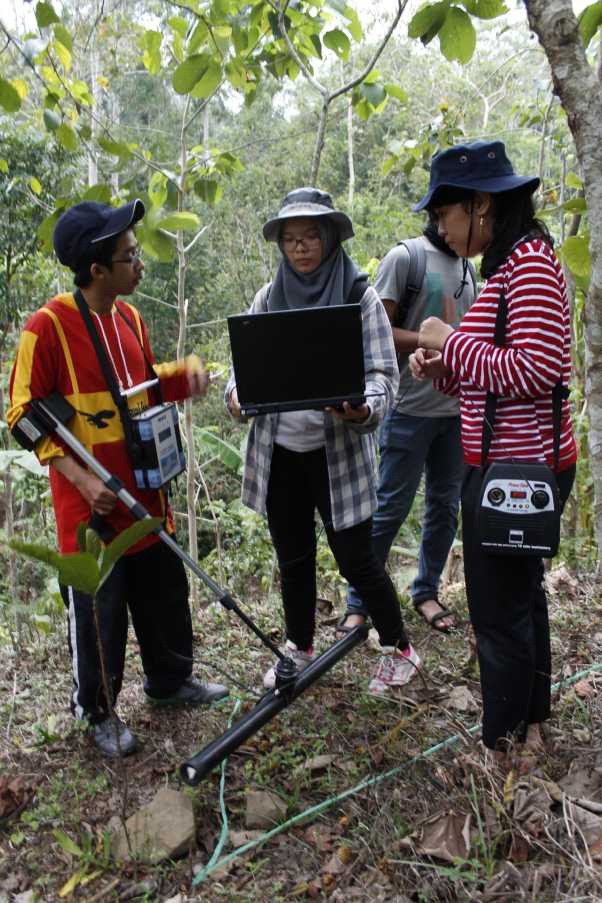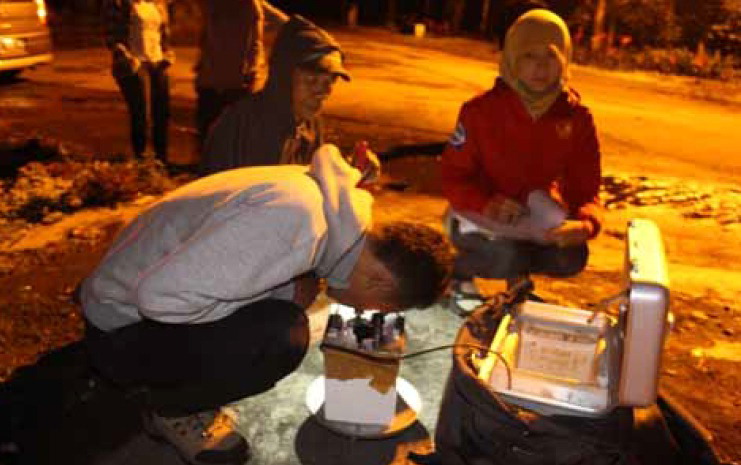Cycle 3 (2014 Deadline) Strengthening research and teaching capacity of Brawijaya University in monitoring and exploring of volcanoes (pilot study: Ijen Volcano complex, East Java)
U.S. Partner: James Foster, University of Hawaii
Project Dates: November 2014 to January 2017
 |
| The project team conducts surveys during multiple field visits (photo courtesy of Dr. Maryanto). |
Around 13% of the world's volcanoes are located in Indonesia; however, few studies have been done and there has been minimal community education on volcano eruptions. To mitigate the hazard, a volcano monitoring system was initiated after Kelud’s eruption in 1919, which killed more than 5,000 people in East Java. Since then, monitoring, education, and research in the field has been minimal. East Java, one of the places most prone to volcanic eruptions in Indonesia, had the most victims affected by volcano eruptions during the 20th century. One of its most active volcanoes, Ijen Volcano, known for its large hyperacidic crater lake, poses significant volcanic and environmental hazards to its immediate surroundings. Besides its threats, the volcano gives some benefits to the surrounding communities due to the prospect of its sulfur mining, tourism, and geothermal energy. In this research project, Ijen Volcano will become a natural laboratory for volcano education and research in all aspects of monitoring and exploration with anticipated social, economic, and environmental impact.
This project aims to develop sustainable and integrated Geophysical Volcano Monitoring and Exploration (GVME) in East Java Province through cooperation between the University of Hawaii and Brawijaya University in research and teaching capacity building by integrating the geophysical approaches. Collaboration between the Indonesian and U.S. partners will promote knowledge transfer, training, and advancements for Indonesian researchers and staff. The expertise of the U.S. partner is expected to strengthen the Indonesian capacity to monitor and explore volcanoes in Indonesia, so that loss and risks caused by such events can be minimized. The research team has an established collaboration with the Indonesian Center for Volcanology and Geological Hazard Mitigation (CVGHM), and much of the capacity building will involve the CVGHM staff and student training through workshops and seminars. Through this project, a new research group on volcanology and geothermal research will be established in Brawijaya University, affiliated with the Research Center for Geosciences and Disaster Mitigation. This unique research center will conduct volcanology and geothermal research in the future.
Final Summary of Project Activities |
| The team conducts an evening gravity survey near the Ijen Volcano Complex (photo courtesy of Dr. Maryanto). |
During this PEER project, which was completed as of the end of January 2017, Dr. Sukir Maryanto and his team conducted a wide range of activities to achieve their goals of improving research and teaching in the field of volcano geothermal studies at their university and beyond. The PI launched his project in November 2014 by creating the Research Group BRAVO ENERGEOBHAS at Brawijaya University. Through this group, he and his students and fellow researchers conducted three major workshops (two onsite at the Cangar-Arjunos Welirang Volcano complex) in 2014 alone. The group also organized two annual Indonesian Conferences on Geothermal and Volcanology in 2015 and 2016 and sent the PI and other participants to present their work at other international and domestic conferences, including the 2016 Annual Meeting of the American Geophysical Union. The team engaged in frequent field work, including geophysical surveys in both volcanic and geothermal areas. They used geophysical methods (magnetotelluric, gravity, magnetic, self potential, and seismic–microtremor) to identify subsurface conditions around the Blawan – Ijen complex and the Arjuno – Welirang volcano. So far, the project has resulted in seven published journal articles, a book authored by the PI, and several technical presentations at conferences and other events.
On the education side, in each of the two years of the project, four students received scholarships. The PEER project also contributed significantly in the establishment of a new doctoral program in the Department of Physics beginning in 2016. The existing curriculum in the department was also enhanced by the addition of field work, especially for the subjects of Physical Volcanology and Geothermal Exploration, with the activities being conducted in the university’s new Field Laboratory of Volcano and Geothermal Studies that was built in 2016. The PI also reports that his work on the PEER project contributed to the development of the new Brawijaya Volcanology and Geothermal Research Center, which had its pre-opening event in December 2016.
The project also facilitated the creation and strengthening of new collaborations between the Brawijaya team and various Indonesian and foreign universities and government agencies in order to share and increase knowledge regarding volcano and geothermal-related issues. At the national scale, Dr. Maryanto and his group have collaborated with the government of the Indonesian city of Batu to sustain geothermal and volcano education in Cangar and also with the Center for Volcanology and Geological Hazard Mitigation. They are also involved in a proposal to USAID’s Sustainable Higher Education Research Alliance (SHERA) program that involves nine other Indonesian universities in an effort to build research capacity in their field. Internationally, the PI collaborates with colleagues at the National Central University Taiwan, National Cheng Khung University Taiwan, University of Neuchatel, and University of Hawaii at Manoa (home institution of his U.S. partner on this PEER project). Thanks to funding provided in 2016 by the Indonesian Ministry of Research, Technology, and Higher Education and the Brawijaya University Research Management Program, the PI and his group are continuing their efforts even though this PEER award has ended, and they are active seeking additional support in 2017 and beyond.
January 2017 article about the PI and his work in Prasetya Online, a publication of Brawijaya UniversityBack to PEER Science Cycle 3 Grants





